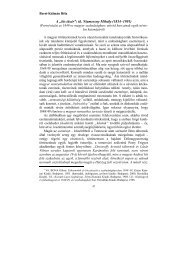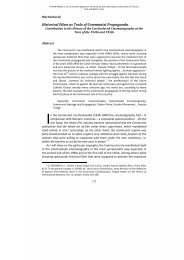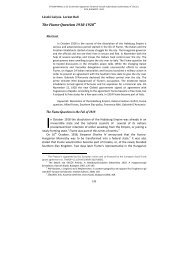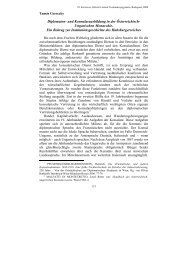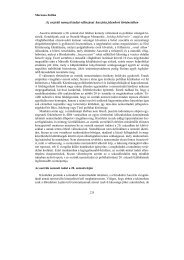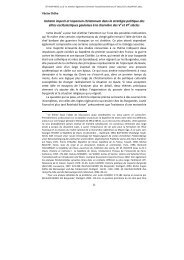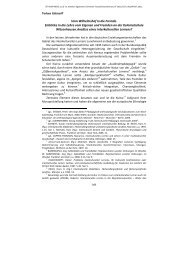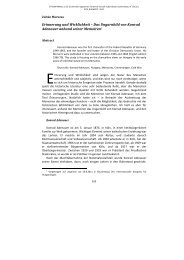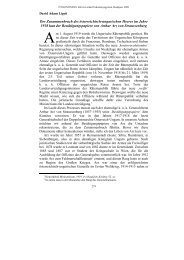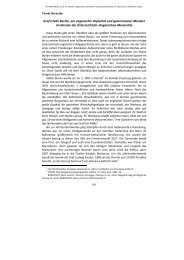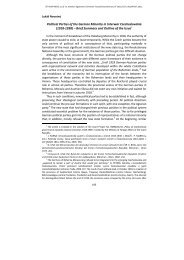The Molotov-Ribbentrop Pact - ELTE BTK Történelem Szakos Portál
The Molotov-Ribbentrop Pact - ELTE BTK Történelem Szakos Portál
The Molotov-Ribbentrop Pact - ELTE BTK Történelem Szakos Portál
Create successful ePaper yourself
Turn your PDF publications into a flip-book with our unique Google optimized e-Paper software.
adoption of the model it became clear, that the form of organization was just<br />
one of several factors that influenced the acceleration of the expulsion of the<br />
Jews. <strong>The</strong> central of the Reich was namely in terms of the numbers from<br />
Vienna, far behind the expectations of the Nazi leaders.<br />
It was quickly noticed, that in Vienna mainly through the pressure from the<br />
state police and the society, the „emigration figures” remained high. Here it<br />
becomes again evident in a sad way that the Austrians did not act according to<br />
the ideology of a German elite. Quite the reverse. <strong>The</strong> Nazis in the „Ostmark”<br />
had, as it is described by Safrian, those in the „Altreich” well ahead. 57<br />
Safrian summarizes the reasons of that „well” functioning model in that<br />
way: „<strong>The</strong> origin, structure, and „success” of the „Zentralstelle” can neither<br />
be oversimplified by crediting Eichmann’s organizational talents nor explained<br />
through the historic growth of bureaucracies and thus exclusively the work of<br />
technocrats of repression or planning. <strong>The</strong>y can be understood only by<br />
including considerations of sociohistorical aspects. <strong>The</strong> example of the<br />
Ostmark in 1938 reveals to what extent a number of factors influenced each<br />
other. Specifically, there were the participation of many thousands of „Aryan”<br />
citizens, non-Jews of presumably „pure” Germanic ancestry, in racist policies,<br />
such policies and, conversely, the aggressive activities of institutions in the<br />
formulation of such policies and their conversion into political measures. In<br />
addition to ideological factors, another reason for the step-by-step<br />
radicalization of anti-Semitic policies is to be sought in „concrete material<br />
interests”.” 58 However, Eichmann and his men pretended that those numbers<br />
of the already fled Jews from Vienna were their work. In doing so, they<br />
justified their further careers in the Nazi power apparatus. 59<br />
From the „emigrations” to the deportations<br />
After German troops occupied Prague on the 15 th of March 1939 there was<br />
also set up a central office („Zentralstelle”) on 26 th of July 1939 following the<br />
Vienna example. It was also led by Eichmann, who became SS-<br />
Hauptsturmführer in the meanwhile. So another about 120.000 Jews came in<br />
the immediate Nazi sphere of influence. 60 After the Munich Agreement<br />
57<br />
SAFRIAN, Hans: Eichmann’s Men. 38: „Because of stronger pressure from below, Austrian<br />
pogrom antisemites’ forging ahead, and internal National Socialist squabbles about distribution of spoils,<br />
Nazi administrators and bureaucrats in Vienna felt pressured much earlier than their counterparts in the<br />
Altreich to devise pseudo-legal procedures and organizational innovations and to create new<br />
administrative machinery for handling these challenges. Moreover, these pressures would not lessen after<br />
1938: <strong>The</strong>y provided the impetus for earlier organization of mass deportations from Vienna than from<br />
other cities of the Greater German Reich, and for their speedy completion by Fall 1942.”<br />
58<br />
Ibid. Eichmann’s Men. 15.<br />
59<br />
Ibid. 36-38.<br />
60<br />
LEGENSTEIN, Roland: Adolf Eichmann - der Schreibtischtäter. Koordinator der<br />
„Endlösung”. Dipl.-Arb., Wien, 2002. 43.<br />
87



